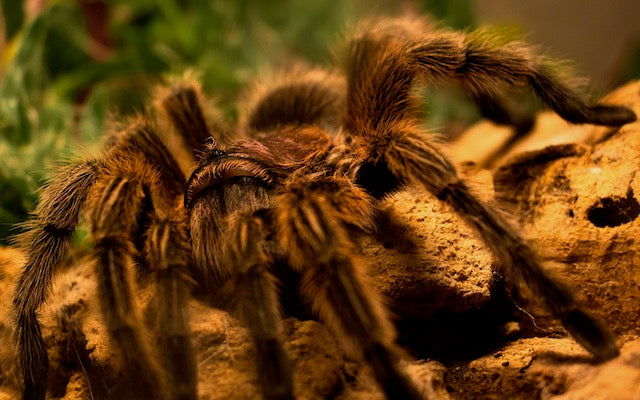Tarantulas are hunters and carnivores. In the wild, they’ll usually eat any prey they can find, whether that’s insects or very small animals like lizards and snakes. If you’re welcoming home a new tarantula, you’re probably wondering, what do pet tarantulas eat? And if you’re at all familiar with exotic pets like bearded dragons, you've probably heard the hype around Dubia roaches. Can tarantulas eat Dubia roaches?
What Do Pet Tarantulas Eat?
Popular feeders for your pet tarantula include:
- Crickets
- Roaches
- Waxworms, superworms, giant mealworms, silkworms, and hornworms
- Smaller spiders
Additionally, some tarantula keepers will feed their pet small lizards, snakes, frogs, and pinky mice, although the majority of what your tarantula eats should be insects.
Because tarantulas aren’t picky, you can give your tarantula virtually any insect. But that doesn’t necessarily mean every insect is good for them all the time. For example, tarantulas enjoy worms, but due to their high fat content, worms aren’t a great daily feeder. Crickets and roaches, on the other hand, make excellent daily feeders.
Pro Tip: Never feed your tarantula wild insects. They can make your spider sick.
Do Pet Tarantulas Eat Dubia Roaches?
Tarantulas can eat three kinds of roaches: Dubia, Turkestan, and Madagascar hissing roaches. If your tarantula is over one and a half inches long, Dubia roaches are a safe feeder option.
Dubia roaches are a popular feeder insect among domestic reptiles; so it may not surprise you to find out that they are an excellent choice for tarantulas as well. In fact, Dubia roaches offer your tarantula some great benefits.
- A healthy treat. Tarantulas love roaches so much that oftentimes they will favor a roach when presented with multiple types of prey. This is especially likely if a tarantula is molting, a time when their body needs a little extra nutrition. So not only are roaches tasty, but they are healthy, too. Dubia roaches are packed with protein, calcium, and Vitamins A and D, and are very filling for your tarantula.
- Easy to keep. Roaches are quiet, fairly clean, don’t bite, don’t stink, and are not good at escaping (they can’t fly or climb smooth walls). Additionally, if they escape, it is very unlikely that they will infest your home, because they can only breed in certain conditions (including 60% humidity with a temperature of 90-95 degrees Fahrenheit).
- Easy to gut load. Dubia roaches are one of the easiest feeders to gut load. Offer them a variety of fruits and vegetables, focusing on any specific nutrients your spider might need.
How Do Tarantulas Eat Dubia Roaches and Other Feeders?
Like any feeder insect, Dubia roaches should be given to your tarantula one at a time or in small numbers. That way, they won’t scatter all over the cage, leaving you with the task of removing dead bugs later on. It will also prevent the insects grouping together to intimidate your tarantula (crickets are notorious for this). Simply use tweezers to drop one or two insects into your spider’s terrarium, and the hunt is on.
Pro Tip: If you have a spiderling, only feed one insect at a time. Spiderlings are still learning to hunt and can become easily overwhelmed.
Of course, you’ll want to make sure the roaches are an appropriate size for your spider to consume. Most Dubia roaches will be fair game, but this depends on the age and size of your spider. Prey should never be longer than half the leg span of your spider.
Ready to try Dubia roaches for your tarantula? Order now.
If you have questions or would like to give feedback, please email us at team@dragonsdiet.com








